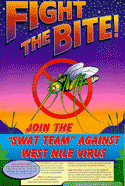West Nile Virus - Veterinary Lab Submission
In 2006, The California Department of Health Services (DHS) and the California Department of Food and Agriculture (CDFA) will supplement the costs (as available funding permits) of diagnostic testing on clinically affected horses for arboviral encephalitis viruses. These include Western Equine Encephalitis (WEE), Eastern Equine Encephalitis (EEE), and West Nile Virus (WNV).
West Nile Virus is a reportable disease in California and private practitioner testing / reporting is the key to successful veterinary surveillance. Timely and accurate case–reporting by the veterinary practitioner is critical to mosquito–control efforts that prevent WNV infection in both horses and humans. It is very important that each laboratory submission form is completed in its entirety. More specifically, it is imperative to include:
- The location(s) of the horse during the two weeks prior to the onset of clinical disease. (Please ensure that this information is included in addition to the "owner’s address".)
- Horse age, breed, and gender.
- Detailed clinical signs; date of onset, the present status of the horse (including alive, dead or euthanized).
- An accurate vaccination history. (Type and dates given)
When this information is included on the submission form it expedites surveillance efforts and eliminates follow–up data retrieval with your clinic and the owner. Your assistance is extremely important and is greatly appreciated.
Submitting Brain Samples of Dead or Euthanized Horses
The local health department and Animal Health District Office must be contacted if rabies is suspected. All equine specimens submitted to local public health laboratories for rabies testing and found to be negative should be sent to CAHFS for Arboviral testing.
Submission of the intact head is preferable because:
- Brain is better preserved (anatomically and virus titer) when left in the skull during transport
- Specimens will be ruined if removal is not done correctly
- Brain removal in field conditions may increase the risk of exposure to rabies
The intact head should be chilled (refrigerated, not frozen) immediately after removal. Submit it to a CAHFS Laboratory as quickly as possible. Prepare a leak–proof insulated transporting container with "cold packs" to keep the specimen at 4o C while in transit. When it is impossible for the CAHFS Laboratory to receive the chilled intact head within 48 hours, the submission protocol should be coordinated with the laboratory.
Specimens will then be forwarded by CAHFS to:
- a Public Health Laboratory for rabies testing, and
- tested for WNV by PCR (Polymerase Chain Reaction) and if required,
- referred to the Arbovirus Laboratory at U. C. Davis or the National Veterinary Services Laboratories (NVSL) for additional arbovirus culture and/or PCR.
California Animal Health and Food Safety Laboratory Submission form (PDF)
For information on sample shipping to the California Animal Health and Food Safety laboratories please contact 530–752–7578.
Equine Veterinarians interested in receiving weekly WNV Confirmed case updates can email wnvirus@cdfa.ca.gov.
If you would like to report a case of WNV in domestic animals (horses, livestock, pets), please contact the CDFA Equine WNV information line: (916) 654–1447.
Additional Links
Public Service Info
Contact Us
CDFA Animal Health and Food Safety Services,
Animal Health Branch
Sacramento, California 95814
Phone: 916-900-5002
Fax: 916-900-5333
Email: ahbfeedback@cdfa.ca.gov


